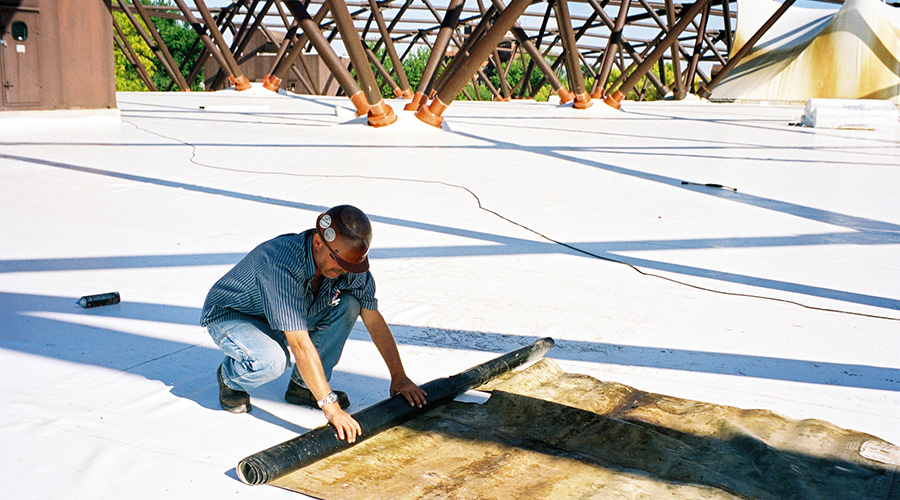Ensuring savings by understanding key concepts, clearing up misconceptions and preparing for maintenance
Much has been written about cool roofs and the urban heat-island effect over the past decade or so, and researchers have published the results of numerous studies.
Traditionally, these studies and technical information have been most important to roofing consultants, contractors, code officials, manufacturers, energy service providers, and architects.
But increasingly, they are important to engineering and maintenance managers, who must answer practical questions about cool-roofing options and plan for the post-installation maintenance of these systems.
What’s Cool, What’s Not
Simply put, a cool roof is reflective transmits the sun’s heat back into the sky rather than transferring it to the building below. It is an energy–efficient roof surface that can keep a building cooler and reduce its energy costs for air conditioning.
Cool roofs can reduce energy consumption, minimize urban heat and help slow the reaction of smog from pollutants. Research has shown that cool roofs also help increase the life expectancy of roofing systems because extreme cycles of heating and cooling tend to wear out materials as they expand and contract with the temperature. Cool roofs on the other hand, keep the roof a more constant temperature and therefore, tend to last longer.
What is the best way to tell if a building’s roof is considered cool, and what steps are required to specify a cool roof?
Managers can achieve cool roofs by using a white or light-colored single-ply membrane, using a cool coating over a black or dark membrane, or using a factory-painted or coated metal system. Cool capsheets, shingles and tiles also are available. Most cool-roof applications have a smooth, light-colored surface.
On a sunny day, dark-colored roofs can be up to 70 degrees hotter than most reflective white surfaces, according to researchers. Obviously, any roof system with a black, or even dark, surface is not a cool roof.
Also, gravel or stone-covered roofs generally are not considered cool, according to the U.S. Environmental Protection Agency’s ENERGY STAR® program.
When is a white roof still not considered cool? If the existing modified bitumen membrane or mineral cap sheet has white granules, it is still not a cool roof by itself that meets Energy Star criteria or ratings used in California’s Title 24. However, several roofing materials manufacturers have developed a granule-surfaced, modified-bitumen membrane with a factory-applied bright white coating that meets Title 24 and is Energy Star listed.
Perhaps surprisingly, not all metal roofs qualify as cool. Bare metals and metallic coatings tend to have low emissivity — a measure of how well a surface material gives off the energy it absorbs — and are not considered cool materials.
Clearing up Myths
Even with the mounds of literature and white papers on technical studies, managers still have misconceptions and gray areas about cool-roof applications.
Myth 1: Cool roofs don’t work in northern climates. The jury is no longer out on whether light-colored or reflective roofs make sense for air-conditioned buildings in warm climates, but differences of opinion remain regarding northern climates.
An 11-city energy-savings study by researchers at the Lawrence Berkeley National Laboratory calculated energy savings by comparing decreased summer costs from lowered air conditioning demand with observed increases in winter heating expenditures.
The results of the research study indicate that in most U.S. climates, summer air conditioning energy savings significantly exceed this winter penalty.
Computer models accounted for the winter energy penalty and still found net savings from light-colored roof systems in the cities studied. In some cities, such as Detroit or Minneapolis, reflective roof systems’ summer savings are less than the increased heating costs in winter. But an independent study of one building near Minneapolis by a roof materials manufacturer found that its cool roof saved energy and money, even in Minnesota.
Myth 2: Eventually, all white roofs turn gray and all black roofs turn gray, so there is no long-term benefit from installing a cool roof.
The reflectivity of a light-colored roof will decrease about 20 percent during its first year according to an LBNL study. Another study found that solar reflectance of white-coated roofs can drop 25 percent, with most of the loss occurring in the first year.
The solar reflectance of cool roofs tends to decrease over time, but another study by LBNL showed that washing a weathered cool-roof membrane resulted in a significant solar reflectance increase. Other studies have shown that modest cleaning can restore about 90 percent of the original solar reflectance.
Some cool roof membranes also have a higher resistance to dirt accumulation than others, so budget-conscious managers might have to weigh the resulting increase in energy use for a dirty membrane against the cost of cleaning.
Myth 3: Using a cool-roof product when reroofing minimizes the need for insulation.
While it is true that using a cool roof on a building with a low level of insulation can generate greater energy savings, an energy–efficient roofing system should have adequate insulation in addition to a solar-reflective surface. To find out what is the optimal amount of insulation for a given location, managers can refer to the International Energy Conservation Code.
Myth 4: If a roofing system has the optimal amount of insulation as recommended by the International Energy Conservation Code, there is no need for cool-roof materials.
In warm climates, managers should probably consider a white, reflective roof a similar priority as roof insulation. Studies by researchers at Oak Ridge National Laboratory have shown that the greatest energy impacts arise from installing a cool roof in a cooling-dominated climate on a poorly insulated building.
Roof color might not make a large difference in energy savings for moderately insulated buildings, but other reasons exist for installing a cool roof on a well-insulated building. These include helping to extend roof life and protecting roof insulation from extremely high temperatures.
Can cool-roof products lengthen the life of roofing systems? Black roofs can get as hot as 170-190 degrees. Using a cool roof can decrease expansion and contraction of the roof system, which might extend the system’s life.
Roof temperatures can rise 90 degrees above ambient air temperature, and these high temperatures can shorten the life of commercial roofing systems made of organic materials.
Beyond Installation
Post-installation considerations for cool roofs are not much different than those the National Roofing Contractor’s Association and the Roof Consultant’s Institute have preached for years.
First, develop and perform an ongoing preventive maintenance program. For example, part of any roof maintenance should be keeping roof drains free of debris. This alone should help a cool roof stay whiter longer because it keeps water from ponding, which collects and holds dirt.
Actually, cleaning a cool roof might not be practical if cleaning costs outweigh the potential energy savings. Before making a decision, managers might have to calculate if the cost of cleaning is worth putting it in the budget every few years.
Coating or recoating a roof might be a cost effective way to reap more energy savings, considering the ever-escalating cost of fuels and energy. When considering coating or recoating, managers need to determine how much life expectancy a roof system has left. If a roof is watertight and needs few repairs, applying a coating might be a good idea.
To help determine if the costs associated with cool roofs are justified, managers can estimate energy savings the roofs can generate in different climates when compared with dark roofs by using an online calculator, such as:
Whether the project involves new construction or replacing or recovering a roof, it pays for managers to research cool roofs by checking out these and other web sites. If need be, they also can get professional assistance early in the project planning.
U.S. businesses spend about $40 billion annually to cool buildings, and the LBNL estimates they could save about $750 million annually in utility bills by using cool roofs. Managers who take the time to learn about cool roofs can help their organizations earn their share of those savings.
Lee Hines is a staff consultant with Benchmark Inc., roof and pavement consultants based in Cedar Rapids, Iowa. He works with Benchmark's multi-facility clients across the nation, performing roof investigations, providing part-time construction observation and writing specifications. He has worked in the roofing industry for more 20 years.
Roofing Resources
Managers seeking more information on current trends and standards related to cool roofs can visit these web sites:
— Lee Hines
|
Spotlight: Cool Roof Rating Council
Thanks to growing market awareness, “cool” roofing is becoming one of the fastest-growing sectors of the marketplace. To meet this trend, the Cool Roof Rating Council (CRRC) was established in 1998 to provide non-biased, accurate energy-performance data for roof surfaces. The CRRC is a non-profit membership organization comprised of roofing product manufacturers and sellers, trade associations, regulatory agencies, and other stakeholders.
The core of the CRRC is its Product Rating Program, a third-party program through which roofing-product manufacturers may label their products with solar-reflectance and thermal- emittance values as measured by independent testing laboratories.
Code bodies, architects, building owners and specifiers can rely on the information provided on the CRRC product label and in the CRRC Rated Products Directory because the CRRC standardizes and assures the quality of the rating process.
A growing number of codes and programs refer to the CRRC Product Rating Program, including:
- California’s Building Energy Efficiency Standard — Title 24
- The U.S. Green Building Council’s Leadership in Energy and Environmental Design (LEED)
- The American Society of Heating, Refrigerating and Air-Conditioning Engineers (ASHRAE).
For more information on the CRRC, visit www.coolroofs.org.
|
Related Topics:











